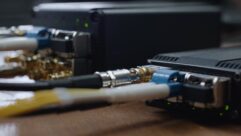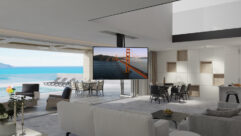When In Rome: Achieving an effective installation at Caesars Palace provedto be an ambitious yet rewarding undertaking.
Jan 1, 1998 12:00 PM,
Craig Schick
When Julius Caesar ruled Rome so long ago, he probably would not havewanted background music and the shouts of excited citizens to interrupt hisspeeches. He would have wanted his every word to reach the ears of hissubjects, in every corner of the capital city. A couple thousand yearslater and half a world away, why should it be any different – even ifCaesar did not to deal with conventions, banks of one-armed bandits andseveral hundred thousand tourists?
Caesar’s Palace casino in Las Vegas employs a highly integrated controlsystem designed to operate, monitor and maintain an exceptional soundingaudio system. The core components used at Caesars are touch-panelinterfaces from AMX of Dallas, and the Universal Digital Audio ProcessingSystem (UDAPS) from Innovative Electronic Designs (IED).
Several phases were required in the completion of the Caesars Palacecomplex A-V system design. The casino system was integrated by our in-housetechnical staff here at Caesars. The convention center A-V system wasdesigned by Pelton Marsh Kinsella of Dallas and was installed by Ford AudioVideo Systems, Oklahoma City.
Components of quality soundThe following system components work together to give us quality sound andsuperior inteligibility:
IED’s UDAPS, which is flexible and expandable enough to handle the massivecabling infrastructure and many different area configurations we have atCaesars.
The ambient analysis system, which allows adjustment of all audio outputlevels to meet our needs. For example, it ensures that audio pages comethrough clearly, whether they are broadcast over the softest backgroundmusic or in a gambling pit full of loud and excited customers.
The monitor/test system, which helps keep the equipment working by alertingus to problems anywhere they may be in the network, minimizing down time.
Haas effect localization – speaker delays that allow more efficientdistribution of sound within a space.
AMX touch panel interfaces within rooms, which allow system access toselect alternate background music sources and values for microphone inputs.
These functions, combined with the high-quality output of the audio system,provide a superb and extrordinarily flexible system for the needs of ourguests in the casino, the hotel and the new convention center.
Wiring the empireThe entire Caesars Palace complex covers nearly 300,000 ft squared (27,870meter squared) of space, which often appears to be in a constant state ofexpansion to keep the environment interesting and exciting. The publicareas audio system (PAAS) has been developed and installed in phases overthe last couple of years. The acronym PAAS may be a bit limiting becauseyou will soon discover that this unique system handles more than just audio.
Regardless of the technical headaches that may arise out of designing andmaintaining such a large system, one essential concept is behind itsdevelopment and installation: If the infrastructure is flexible enough andis designed with the ability to communicate in both directions, one canpretty much accomplish anything to do with audio and video control. Thedesign allows the system to communicate via different methods and iscompetely accessible no matter where we are within this enormous property.The beauty of this method is that there is always access to a subsystem toexpand when necessary.
The entire system intrastructure is designed to combine both the originallayout and new expansion using copper wiring and fiber optics for allpurposes except the original conduit bus. PAAS consists of individual nodeson a conduit bus, divided into three distinct sections: one forloudspeakers, another for ambient sensors, and the third for controls, suchas miscellaneous methods of communications, volume controls, paging systemsand microphone stations. Junction boxes are located at strategic places inthe conduit bus, and we can connect into the system from any of them,allowing us to reconfigure from any junction box location.
The subsystems that aren’tThe big junction boxes on the conduit bus allow the subsystems, such asthose in the restaurants, to be a part of the flexible platform. In orderfor this to happen, the subsystems need to tie back into the control bus.These systems communicate with the rest of the network through the AMXAxcess bus (for remote communications) and receive remote audio on shieldedcable. All subsystems have the ability to receive commands to shut down incase of a fire alarm, and they don’t even need a local music source becausewe have the ability to route the satellite DMX antenna feed into any areathroughout the conduit bus at speaker level.
Incorporating the sub-systems into PAAS was also a money-saving idea.Running conduit everywhere would have been extremely expensive. Theflexibility of this system allows areas that are not technically part ofthe conduit bus to have the same quality sound as the rest of the facility.
New pathways at CaesarsWith the new conduit bus infrastructure in place, we can now branch offinto other areas of Caesars. From the new PAAS control room, we have a feedfor the new convention center. Another branch runs to the satellitedownlink facility,which allows us to send and receive audio and video, viacopper and fiber-optic cables, anywhere that is pertinent. Yet another feedfrom the new audio room runs to the MATV head-end room, where we generatepay-per-view and other signals sent to the cable system throughout theproperty. We can also input music into the cable system to give customersin our hotel rooms uninterrupted DMX music sourced from our satellitesystem. From the satellite downlink, we also conect back to the MATVhead-end.
Another feed from the new audio room goes to the pool area, which isseparately configured into several different areas; sort a a microcosm ofPAAS. Unlike other facilities where the audio system for the pool areaconsists of twisted-pair for speakers, our intrastructure allows manyunique configurations with various levels of attenuation. Ambient sensingis also available, which is necessary outdoors in Las Vegas because ofextreme noise levels generated from the winds that roar in from the West.We can even configure the system for outdoor bands by inputing signals backinto the network, which allows control of different parts of the pool areafrom the pool area itself without relying on the master control. Furtherexpansion allows distribution of audio into individual cabanas for privateevents.
Clamor from Caesar’s loyal subjectsTwo main places where we are concerned most with sound quality are the slotmachine rooms and the gambling pit, both of which put the system’s ambientsensing capabilities to the best use.
A considerable amount of noise is generated in the slot machine area -customers talking, sound effects from machines, the clatter of coinshitting the jackpot trough – which, in the past, could have made pages andother announcements difficult to hear. However, the overall level of thenoise in the slot machine area is constant. When you get to the gamblingpit, however, the noise level can vary greatly depending upon how manycustomers are enjoying themselves there. Regardless of the noise level, thesystem’s ambient sensing can now monitor the area and increase or decreasethe sound level of audio pages and announcements as necessary.
A related technology is used for a major daily event: the Caesar Parade,where “Caesar” and his large entourage parade through the casino. Caesar’slead bodyguard, wearing a wireless microphone, calls out for people to”make way for Caesar.” In order for the customers to enjoy the littleparade, the system uses what is known as a “Caesar locator” to filter outany background music in the area where the bodyguard or Caesar is speaking.The closest microphone receiver to pick up the signal sends a closurefeedback signal to the UDAPS, which then fades out any background music orpages to that area.
Easy configuration changesThe system’s flexibility helps us when we need to reconfigure areas forother events as well. If a music act is to perform in a room one day and abusiness meeting is to be held there the next, we can simply reconfigurethe room with the UDAPS software from the control room.
In addition, each room contains an AMX touch-panel interface that allows usto change background music sources and microphone locations for moreefficient sound control. Once a user makes a change at a panel, it is sentto the UDAPS, which makes the adjustments for that room. This local controlhelps when rooms need to be reconfigured quickly.
The wandering minstrelWithin the casino, sensors are installed in the areas where bands are toperform. All functions controlling the ambient systems are programmed intothe network as event times that are scheduled to occur at specific timeswhen the bands are scheduled to play. As always, there are exceptions tothis timing schedule, and the ambient sensing devices are also activated byturn-on triggers set up between the network and the amplification used bythe instrumentalists. These control signals allow the network times to beoverridden so the pre-programmed functions will occur during theperformance even if the band starts up earlier than scheduled.
Haas (effect) partyGambling, music and good times are not the only events going on daily atCaesars. We frequently host business meetings, presentations andreceptions, but they are not excluded from the benefits of quality audiosignals.
Regardless of the presentation being made in a room – whether it is aspeech, panel discussion or even a concert performance – audience membersseated toward the back may hear two different signals: one from thepresenter and another from the closer ceiling speakers. A phenomenon knownas the Haas (or precedence) effect states that if the same sound reachessomeone from two directions, the brain will localize the source in thedirection of the first sound arrival. That can be aggravating to listenersif the first sound that reaches them is coming from the ceiling speakeroverhead and the second one is coming from the stage at the far end of theroom.
To reinforce and focus the sound, delays are programmed into a room’sspeakers so that the Haas effect is minimized and sound seems to fill thewhole room at once. These delays can be reprogrammed based on where thepresenter’s stage is to be positionedwithin the room regardless of theevent type.
This reprogramming is performed at the system computer by dragging an iconrepresenting the stage in a graphical representation of the area and”dropping” it in the appropriate location on the screen. The computerautomatically calculates the delay time for this stage location, takinginto account ceiling height in the room.
A picture is worth a thousand reconfigurations
The graphical portion of the UDAPS software allows us to always have anup-to-date “map” of our system, which makes it easier to program areas thathave been reconfigured. Once we decide an area needs reconfiguration, wemake the hardware changes and then reflect them in the software. Once thereconfiguration is finished, we can easily perform such tasks as the stagelocation reprogramming to reduce Haas effect.
Always up and runningKeeping a complex, efficient sound system operating constantly in a hugeenvironment such as Caesar’s is made easier with the monitor test system,which continuously checks every point within the system’s intrastructure.Should a problem occur, we get immediate notification. Another nice featureof the system is the ability to program the alert time in the UDAPS to keepthe system from reporting errors that may just be minor, temporary glitchesoccurring during everyday use.
Therefore, we are able to deal with a small equipment problem before itbecomes a crisis. Monitor test helps us make sure our system is operatingat 100% capacity all the time.
It will be a busy, exciting time for Caesars Palace before the beginning ofthe next millenium. Even with all the expansions and new construction, wecan count on our multicomponent audio system to provide quality soundoutput, regardless of noises or events, in existing facilities or anywhereelse we may build.









